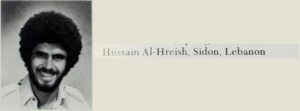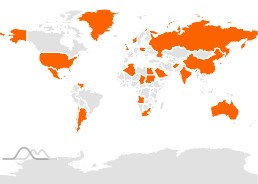Since at least 1909, Lebanese students have been attending the University of Illinois. They have included architects, civil engineers, coaches, electrical engineers, entomologists, instructors, professors, sociologists, and writers too.
Read on to learn more about early Lebanese Illini!
Early Illinois – Lebanon Connections
At least two faculty members had connections with Lebanon, and one connection formed shortly after World War II. In fact, it was as early as 1948, when Agronomy and Plant Genetics Professor Jack R. Harlan (Record Series 8/6/25) visited Lebanon, as part of a four-country expedition, and his trip is documented in collection lists, field notes, and photographs too. Just a few decades later, more recently, poet, singer, songwriter, and French and Comparative Literature Professor (1988-2004) Evelyne Accad (Record Series 15/9/26) taught at the University, and Dr. Accad’s course materials, research notes, and unpublished works can be viewed in the University Archives too.
Early Illini in Lebanon
Even earlier than faculty connections, some early Illini alumni worked in Lebanon. Those stories might begin in 1900, with Mr. Edward F. Nickoley, (A.B. Literature and the Arts, 1898; PhD, 1932), of Long Grove, Illinois, and the son of Prussian immigrants to the U.S., who was briefly an assistant principal at West Aurora High School in Aurora, Illinois before becoming principal of the School of Commerce at the Syrian Protestant College in Beirut (now American University of Beirut). [1] Mr. Nickoley was the Acting President of the AUB (1919-?), Dean of the Faculty of Arts and Sciences, (1924-?), and was even the Acting Principal of the International College (1936-1937) until his death.
In fact, Ms. Emma May Rhoads, (A.B. 1899; A.M. English, 1915), of Ottawa, Illinois, married Mr. Nickoley in 1899, before they both relocated to Lebanon in 1900. [2]
Shortly after the Nickoleys arrived in Beirut, Mr. Nuba M. Pletcher, (A.B, 1901; A.M., 1903), of Hoopeston, Illinois, joined the teaching staff at AUB as an instructor of English and History. [3] After returning to the U.S., Mr. Pletcher completed a doctorate at Columbia University, and he became a professor at the Shattuck School (now Shattuck-St. Mary’s School), in Faribult, Minnesota.
Just a few years later, future Armenian Illini Mr. Garabed A. Z. Garabedian, (A.B. Science, 1910), of Constantinople, attended the AUB for academic year 1906-1907, before transferring to Illinois. [4] Mr. Garabedian remained in the U.S. where he worked as a medical doctor in Tulsa, Oklahoma.
Later, Mr. Louis A. Boetigger, (A.B. Literature, Arts, and Science, 1914), of Chicago, was a commerce instructor at AUB (1914-1917) where he met and married a Ms. Berdjouhi Haroutunian in Beirut, after graduation, before continuing his graduate education at the University of Minnesota. [5] In fact, just a few years after the wedding, Mr. Boetigger would later publish at least one sociological study on Armenian legends and festivals.
At the same time as Mr. Boeitigger’s tenure, future Palestinian Illini Mr. Saleem R. Farah, (B.S. Agriculture, 1916), of Nazareth, prepared at AUB, before coming to Illinois. [6]
Early Lebanese Illini
The first Lebanese Illini might have been Mr. Shukry El-Aswad, (Civil Engineering, 1909-1910), of Brummana, Lebanon, who was the first university soccer coach from 1909 until he withdrew in 1910 to continue his education at Columbia University. At that time, today’s “soccer” in American English was sometimes also known as “soccer football“. During his year at the University, Mr. El-Aswad was a member of the multicultural student organization Cosmopolitan Club, and Cosmopolitan Club even played a role in popularizing the sport on campus. Through the Cosmopolitan Club, Mr. El-Aswad gave at least one campus talk on Syria too. As the first soccer coach, Mr. El-Aswad actively developed the 1910 Spring Team as the sport’s popularity grew nationally. That same year, Mr. El-Aswad tried-out for the Track Team in a 35-yard dash (and he came in third place). While on the 1910 Illinois Track Team, Mr. El-Aswad competed in Relay against Chicago. He also played chess too.
The first Lebanese Illini graduate might have been Mr. George Y. Bijjani, (M.S. Entomology, 1936; PhD Entomology, 1954), of Zahlé, Lebanon. Mr. Bijjani attended the American Boy’s School in Sidon, Lebanon, and he attended the AUB for one year, before completing a bachelor’s degree at Alma College in Michigan. At Illinois, Mr. Bijjani completed a master’s degree in entomology, before returning to Lebanon as an instructor at the AUB for almost a decade. While in Beirut, Mr. Bijjani met his wife, and they returned to Illinois where Mr. Bijjani completed his PhD. After graduation, Dr. Bijjani first joined the faculty at the University of Dubuque, before joining the faculty at the College of Emporia.
While he was a student, Dr. Bijjani was a frequent speaker on and off campus. Some topics and meetings included a talk on customs, crops, and entomological issues in Lebanon, for the campus insect club Hexapoevia (October 1934), “What the Near East Relief Did For Me“, for the McKinley Memorial Presbyterian Church (June 1935), the University Place Church (March 1937), and the Urbana Exchange Club (March 1948), “Recollections of the War”, for the First Congressional Church (October 1935), “Why Missions”, for the McKinley Foundation (November 1936), and “Philosophy of Life”, for the McKinley Foundation (December 1936). Dr. Bijjani was an active teacher too. At least as early as September 1935, he was an elementary and intermediate Arabic instructor at the Hillel Foundation. At the 1935 YMCA-YWCA annual meeting, he played Syrian music alongside Turkish students and Jewish students too. He was also a member of the YMCA International Friendship Committee too, which was a volunteer group which promoted socialization between visiting foreign (now “international”) students.
After returning to campus after World War II, Dr. Bijjani would resume speaking on campus and teaching off campus too. In early 1948, Dr. Bijjani was one of three speakers for a panel on the significance of the partition of Palestine (January 1948). One Daily Illini writer favorably reviewed the talk, while another student editorial criticized the talk. At least as early as 1953, Dr. Bijjani was also a Bible study instructor at the McKinley Foundation (February 1953), and he was named a member of the Foundation’s honorary society too.
Lebanese student enrollment may not have become consistent until the 1960s. In fact, the early 1960s’ Illios document multiple Lebanese students. (Just take a look above and below!)
Unfortunately, not much more information has been identified yet.
And although documentation of Lebanese Illini after the 1960s is limited, student enrollment figures document that Lebanese Illini enrollment has continued uninterrupted, since at least 1967.
Are you a Lebanese Illini? Do you know someone who is? We’d like to hear from you! Please send us a message or leave a comment below. We want to include you and your story, as we celebrate the first 150 years of the University of Illinois.
Happy First 150 everyone!
[1] “Edward Frederick Nickoley”, The Semi-Centennial Alumni Record of the University of Illinois, Edited by Franklin W. Scott, page 113-114. For Economics Professor Simon Litman’s correspondence with Dr. Nickoley, please see the Simon Litman Papers (Record Series 9/5/29). For Mr. Edward Nickoley’s professional papers, please see the “Edward Nickoley Collection, 1917-1969“, at the Archives and Special Collections Department, Jafet Memorial Library, American University of Beirut.
[2] “Emma May Rhoads (Nickoley)”, page 123.
[3] “Nuba Mitchel Pletcher”, page 152.
[4] “Garabed A. Z. Garabedian”, page 377.
[5] “Louis Angelo Boetigger”, page 522.
[6] “Saleem Raji Farah”, page 617.







